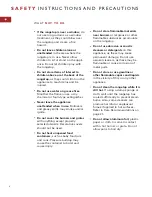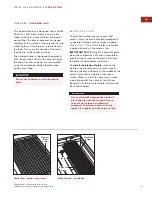
20
W O L F G A S R A N G E T O P
C A R E
C L E A N I N G
T H E R A N G E T O P
R A N G E T O P C L E A N I N G T I P S
Wait until surfaces are cool before cleaning.
Wipe up spills and spatters as they occur
and immediately after the rangetop has
cooled. If spatters are allowed to cook on,
they may permanently damage or stain the
finish.
Use caution when spraying cleaners. Some
contain caustic ingredients that can damage
adjacent parts and finishes. Protect adjacent
parts by masking them off before spraying.
Do not spray cleaners on electrical controls,
igniters, wires or switches.
Refer to pages 13–19 for specific care
instructions for the charbroiler, griddle and
French Top.
D R I P P A N R E M O V A L
The drip pan removal hook (part #722218) is
provided with the rangetop to lift and remove
the porcelainized steel top for cleaning.
To remove the drip pan, first remove the cast
iron grates. Insert the vinyl-coated end of the
drip pan removal hook into one of the oblong
holes in the drip pan. Lift upward and set
the drip pan aside for cleaning. Refer to the
illustration below.
Drip Pan
Removal Hook
Porcelain Top
Porcelain top removal
A C C E S S O R I E S
Optional acces-
sories are available
through your
Wolf dealer. To
obtain local dealer
information, visit
the Locator section
of our website,
wolfappliance.com.
C O O K WA R E
S E L E C T I O N
For best results, we recommend medium- to
heavy-weight pans that have a flat base, metal
handle and a good-fitting cover. Look for pans
that are made of materials with good heat
conductivity, such as aluminum and copper.
Use the following guidelines when selecting
cookware for the rangetop:
Select high-sided (deep) pans rather than
ones with very wide bases and low sides.
High sides will minimize boilovers.
When using pans made of cast iron,
enameled steel or glass ceramic, or coated
with a nonstick finish, select lower flame
settings. High heat applied to such materi-
als will cause ”hot spots” and scorching.
Cover pans while cooking; covers improve
cooking efficiency. Water boils faster, using
less fuel, and the kitchen stays cooler.
Use the front burners for larger pans. The
pans are easier to handle, especially when
hot.
Pans with oversize bases that extend
beyond the rangetop frame should not be
used. On HIGH settings, heat may be
trapped beneath the pan causing perma-
nent damage to the surface finish.
Use a wok with a flat bottom.





































